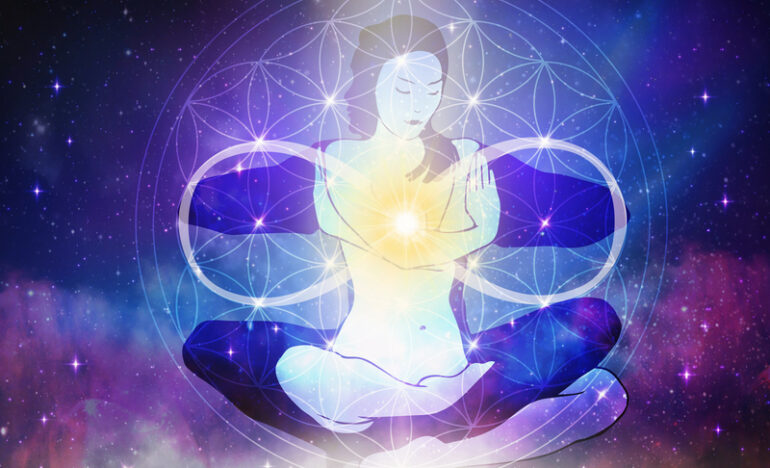Shekhinah: The Indwelling Presence of God

By Kathy Keary
Our full series on Contemplative Life is here.
Our new series on Judaism and Contemplation is here.
In our initial article on Shabbat, we mentioned that prior to the Friday evening meal, families take a moment to welcome Shekhinah, the Divine Presence. In this article, we will delve into this moving depiction of God. One of my favorite meditative songs is a beautiful mantra entitled “Shekhinah” by Monica Brown. The words describe our relationship to the indwelling Spirit of God:
Shekinah, Shekinah of God,
Presence that is seen and touched, heard and felt;
Indwelling of God,
Shekhinah, Shekhinah of God,
The temple, the temple of God is sacred,
And you, you are the temple.
Rabbinic mystics use the term, Shekhinah, a feminine Hebrew noun for God, to describe the indwelling of God’s Spirit in the human soul. The song is an invitation to be alive to God’s indwelling presence in our own being, that of others, and all of creation (Brown). That is the essence of a contemplative spirituality – a spirituality that is animated by Love that makes a home in the depths of our being.
Today the term, Shekhinah, usually refers to the divine feminine or the feminine aspects of God such as God as mother, nurturer, protector, and compassionate one. This word is found in early rabbinic literature; however, it was used to refer to God’s presence among the people and a gender was not associated with it. It is mainly in the Jewish mystical literature where the word, Shekhinah, takes on a feminine connotation. Jewish feminist embraced this concept to counterbalance the predominant masculine depiction of God as king, father, and judge (My Jewish Learning).
Throughout Jewish history, Shekhinah has come to the aid of her people. It was Shekhinah who led the Israelites through the desert as they fled enslavement in Egypt. “By day the LORD went ahead of them in a pillar of cloud to guide them on their way and by night in a pillar of fire to give them light, so that they could travel by day or night (Exodus13:21). Shekhinah dwelled in the Ark of the covenant and rested in the innermost sanctum of the Temple in Jerusalem (Starr, 157).
Throughout history whenever the Israelites were in exile, they firmly believed that Shekhinah was exiled with them. The Jewish people do not believe that God’s immanence was destroyed with the destruction of the temple. Rather they hold that the Divine Presence guards over the people wherever they find themselves. The fact that God revealed himself to Moses in a thorn bush, reveals that Shekhinah is everywhere (Areil, 91).
Note: Never miss an article published on the Renewal Center website: Sign up to receive our newsletters.
When a rabbi blesses the congregation or a parents bless their children, they do so with upstretched hands. It is believed that the upraised hands create a space were Shekhinah is encountered. The rabbi or parent draws the energy of the Divine Presence to themselves in this act. They are then able to convey the Shekhinah energy to others (Novick, 181).
Rabbi Leah Novick in her book, On the Wings of Shekhinah: Rediscovering Judaism’s Divine Feminine, devotes an entire chapter to the role the Divine plays as we sleep. She explains:
Jewish thinking presents dreams as messages from the Divine – signals to enable us to understand ourselves better and to realign our lives with the divine plan… Dreams represent an intimate and direct personal communication between the individual and the Ruach ha Kodesh, [Holy Spirit in Hebrew], similar to the gift of prophecy and vision… We can regard them as an inside line to Shekhinah. Mother and educator, she uses our unconscious to alert us to feelings and situations that we are less likely to access in our busy waking state (Novick, 157).
I encourage you to take a look at my article, “Glowing Among Us” as it speaks of my personal experience of receiving a divine message in a dream. The belief that the Divine communicates with us in our dreams is not only a Jewish understanding but finds a home in the major faith traditions of the world.
I refer you to our previous article, “It’s All About the Kiss,” that addresses the soulful communion with the Divine. Our series, “Contemplation,” focuses on a prayer practice that fosters intimacy with the Mystery that abides deep within. These articles are written from a Christian perspective; however, share similarities with the Jewish understanding of Shekhinah. Our article, “The Indwelling Spirit of God,” speaks of this sacred reality from an Islamic perspective.
Next week we will continue our exploration of the treasures found in Judaism. Until then, may you experience Shekhinah deep within your soul and allow the Divine Presence to radiate from you touching the lives of those you encounter.
References
Brown, Monica. Holy Ground. Monica Brown and Emmaus Productions. 2000
Novick, Rabbi Leah. On the Wings of Shekhinah: Rediscovering Judaism’s Divine Feminine. Wheaton, Illinois: Theosophical Publishing House, 2008.
“Shekhinah: The Divine Feminine.” My Jewish Learning. https://myjewishlearning.com/article/the-divine-feminine-in-kabbalah-an-example-of-jewish-renewal
Starr, Mirabai. God of Love: A Guide to the Heart of Judaism, Christianity and Islam. Rhinebeck, New York: Monkfish Book Publishing Company, 2012.
Illustration 179895259 / Divine © Alexandra Barbu | Dreamstime.com
We’d Like to Hear from You!
We’d like to know what you think about this article. Send us a comment using the form below. Do you have a suggestion? Is there something you want to learn more about? Send us a note.
Related

Take Nothing for the Journey
An Assembling God’s Puzzle video
By Fr. Garry Richmeier, C.PP.S.
Jesus’ teaching about what to take on a journey — nothing — is actually good advice for building trusting relationships. Don’t bring your “stuff” into the relationship; listen deeply and respec their views and situation, understand their struggles.

Pilgrims of Hope, Episode 6: Walking with Cancer Survivors
Hosted by Fr. Ron Will, C.PP.S.
We are talking with people who find hope amid difficult circumstances or bring hope to others. In this episode, Kathy Keary talks about how centering prayer, journaling and other spiritual practices helped her cope with two life threatening health issues.
Categories
Assembling God's Puzzle Coffee with Padre Cooking & Spirituality Encounters of the 4th Kind Family Matters Reflections on the Eucharsitic Prayers Spiritual Resources Taize Prayers The Contemplative Life Traveling with Pilgrims of Hope Uncategorized Videos Week of Prayer for Uhristian Unity When you need a little help
